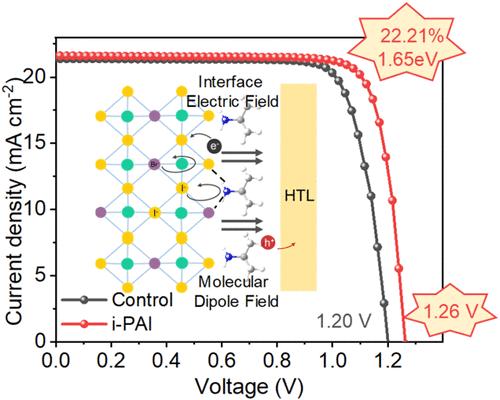高性能宽禁带钙钛矿太阳能电池的双场钝化策略
IF 8.2
2区 材料科学
Q1 MATERIALS SCIENCE, MULTIDISCIPLINARY
引用次数: 0
摘要
宽带隙过氧化物太阳能电池(WBG PSCs)因其在串联光伏技术中的理想应用而受到越来越多的关注。然而,宽带隙包晶往往会形成高密度陷阱态,导致严重的非辐射重组和相分离,这不利于宽带隙包晶太阳能电池的效率和稳定性。在这项工作中,引入了一种由氢碘酸异丙胺(i-PAI)促进的双场钝化策略,实际上同时显示了分子偶极子场钝化和界面电场钝化。这一策略降低了 WBG 包晶的电荷阱密度,抑制了相分离,实验数据和模拟结果的分析都证明了这一点。此外,双功能钝化还将 WBG(1.65 eV)PSC 的开路电压(VOC)缺陷降低到 0.39 V,并将效率提高到 22.21% 的极高值。该器件还表现出出色的光稳定性,在 1 太阳白光 LED 下照明 1080 小时后,仍能保持 84.2% 的初始效率。这项工作展示了一种关键的缺陷钝化途径,可显著提高宽带隙过氧化物太阳能电池的效率和稳定性。本文章由计算机程序翻译,如有差异,请以英文原文为准。

Dual Field Passivation Strategy for High-Performance Wide-Bandgap Perovskite Solar Cells
Wide-bandgap perovskite solar cells (WBG PSCs) have been receiving increasing focus due to the ideal application in tandem photovoltaics. Nonetheless, WBG perovskites tend to form high-density trap states, causing serious nonradiative recombination and phase segregation, which is detrimental to the efficiency and stability of WBG PSCs. In this work, a dual-field passivation strategy facilitated by isopropylamine hydroiodide (i-PAI) is introduced, in effect, showing both the molecular dipole field passivation and interface electric field passivation. This strategy reduces the charge trap density of WBG perovskite and suppresses the phase segregation, which is supported by the analysis of the experimental data and simulation results. Moreover, the dual functional passivation mitigates the open-circuit-voltage (VOC) deficit of the WBG (1.65 eV) PSCs to 0.39 V and increases the efficiency to a competitive value of 22.21%. The device also exhibits excellent photostability, maintaining 84.2% of the initial efficiency after 1080 h of illumination under 1-sun white LED. This work showcases a pivotal pathway to defect passivation that can markedly enhancing both the efficiency and stability of wide-bandgap perovskite solar cells.
求助全文
通过发布文献求助,成功后即可免费获取论文全文。
去求助
来源期刊

ACS Applied Materials & Interfaces
工程技术-材料科学:综合
CiteScore
16.00
自引率
6.30%
发文量
4978
审稿时长
1.8 months
期刊介绍:
ACS Applied Materials & Interfaces is a leading interdisciplinary journal that brings together chemists, engineers, physicists, and biologists to explore the development and utilization of newly-discovered materials and interfacial processes for specific applications. Our journal has experienced remarkable growth since its establishment in 2009, both in terms of the number of articles published and the impact of the research showcased. We are proud to foster a truly global community, with the majority of published articles originating from outside the United States, reflecting the rapid growth of applied research worldwide.
 求助内容:
求助内容: 应助结果提醒方式:
应助结果提醒方式:


